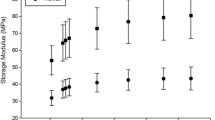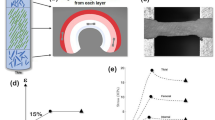Abstract
Quantification of the compressive material properties of the meniscus is of paramount importance, creating a “gold-standard” reference for future research. The purpose of this study was to determine compressive properties in six animal models (baboon, bovine, canine, human, lapine, and porcine) at six topographical locations. It was hypothesized that topographical variation of the compressive properties would be found in each animal model and that interspecies variations would also be exhibited. To test these hypotheses, creep and recovery indentation experiments were performed on the meniscus using a creep indentation apparatus and analyzed via a finite element optimization method to determine the material properties. Results show significant intraspecies and interspecies variation in the compressive properties among the six topographical locations, with the moduli exhibiting the highest values in the anterior portion. For example, the anterior location of the human meniscus has an aggregate modulus of 160 ± 40 kPa, whereas the central and posterior portions exhibit aggregate moduli of 100 ± 30 kPa. Interspecies comparison of the aggregate moduli identifies the lapine anterior location having the highest value (450 ± 120 kPa) and the human posterior location having the lowest (100 ± 30 kPa). These baseline values of compressive properties will be of help in future meniscal repair efforts.
Similar content being viewed by others
REFERENCES
Adams, M. E., and H. Muir. The glycosaminoglycans of canine menisci. Biochem. J. 197:385–389, 1981.
Anderson, D. R., S. L. Woo, M. K. Kwan, and D. H. Gershuni. Viscoelastic shear properties of the equine medial meniscus. J. Orthop. Res. 9:550–558, 1991.
Arnoczky, S.P., C.A. McDevitt, M.B. Schmidt, V.C. Mow, and R. F. Warren. The effect of cryopreservation on canine menisci: A biochemical, morphologic, and biomechanical evaluation. J. Orthop. Res. 6:1–12, 1988.
Arnoczky, S. P., R. F. Warren, and C. A. McDevitt. Meniscal replacement using a cryopreserved allograft. An experimental study in the dog. Clin. Orthop. 252:121–128, 1990.
Athanasiou, K. A., A. Agarwal, and F. J. Dzida. Comparative study of the intrinsic mechanical properties of the human acetabular and femoral head cartilage. J. Orthop. Res. 12:340–349, 1994.
Athanasiou, K. A., A. Agarwal, A. Muffoletto, F. J. Dzida, G. Constantinides, and M. Clem. Biomechanical properties of hip cartilage in experimental animal models. Clin. Orthop. 316:254–266, 1995.
De Boer, H. H., and J. Koudstaal. The fate of meniscus cartilage after transplantation of cryopreserved nontissue-antigen-matched allograft. A case report. Clin. Orthop. 266:145–151, 1991.
DeHaven, K. E. Meniscus repair. Am. J. Sports Med. 27:242–250, 1999.
Elliott, D. M., F. Guilak, T. P. Vail, J. Y. Wang, and L. A. Setton. Tensile properties of articular cartilage are altered by meniscectomy in a canine model of osteoarthritis. J. Orthop. Res. 17:503–508, 1999.
Fithian, D. C., M. A. Kelly, and V. C. Mow. Material properties and structure-function relationships in the menisci. Clin. Orthop. 252:19–31, 1990.
Goertzen, D., J. Gillquist, and K. Messner. Tensile strength of the tibial meniscal attachments in the rabbit. J. Biomed. Mater. Res. 30:125–128, 1996.
Goertzen, D. J., D. R. Budney, and J. G. Cinats. Methodology and apparatus to determine material properties of the knee joint meniscus. Med. Eng. Phys. 19:412–419, 1997.
Hacker, S. A., S. L.-Y. Woo, J. S. Wayne, and M. K. Kwan. Compressive properties of the human meniscus. Trans. Orthop. Res. Soc. 17:627, 1992.
Joshi, M. D., J. K. Suh, T. Marui, and S. L. Woo. Interspecies variation of compressive biomechanical properties of the meniscus. J. Biomed. Mater. Res. 29:823–828, 1995.
Klompmaker, J., H. W. Jansen, R. P. Veth, H. K. Nielsen, J. H. de Groot, A. J. Pennings, and R. Kuijer. Meniscal repair by fibrocartilage? An experimental study in the dog. J. Orthop. Res. 10:359–370, 1992.
Lechner, K., M. L. Hull, and S. M. Howell. Is the circumferential tensile modulus within a human medial meniscus affected by the test sample location and cross-sectional area? J. Orthop. Res. 18:945–951, 2000.
Leslie, B. W., D. L. Gardner, J. A. McGeough, and R. S. Moran. Anisotropic response of the human knee joint meniscus to unconfined compression. Proc. Inst. Mech. Eng. [H]. 214:631–635, 2000.
Mak, A. F., W. M. Lai, and V. C. Mow. Biphasic indentation of articular cartilage-I. Theoretical analysis. J. Biomech. 20:703–714, 1987.
McAndrews, P. T., and S. P. Arnoczky. Meniscal repair enhancement techniques. Clin. Sports Med. 15:499–510, 1996.
Mow, V.C., M.C. Gibbs, W.M. Lai, W.B. Zhu, and K.A. Athanasiou. Biphasic indentation of articular cartilage-II. A numerical algorithm and an experimental study. J. Biomech. 22:853–861, 1989.
Mow, V. C., S. C. Kuei, W. M. Lai, and C. G. Armstrong. Biphasic creep and stress relaxation of articular cartilage in compression? Theory and experiments. J. Biomech. Eng. 102:73–84, 1980.
Mow, V.C., A. Ratcliffe, K.Y. Chern, and M.A. Kelly. “Structure and function relationships of the menisci of the knee.” In: Knee Meniscus: Basic and Clinical Foundations, edited by V. C. Mow, S. P. Arnoczky, and D. W. Jackson. New York: Raven, 1992, pp. 37–57.
Noble, J. Lesions of the menisci. Autopsy incidence in adults less than fifty-five years old. J. Bone Joint Surg. Am. Vol. 59(4):480–483, 1977.
Proctor, C. S., M. B. Schmidt, R. R. Whipple, M. A. Kelly, and V. C. Mow. Material properties of the normal medial bovine meniscus. J. Orthop. Res. 7:771–782, 1989.
Skaggs, D. L., W. H. Warden, and V. C. Mow. Radial tie fibers influence the tensile properties of the bovine medial meniscus. J. Orthop. Res. 12:176–185, 1994.
Stone, K. R., W. G. Rodkey, R. J. Webber, L. McKinney, and J. R. Steadman. Future directions. Collagen-based prostheses for meniscal regeneration. Clin. Orthop. 252:129–135, 1990.
Tissakht, M., and A. M. Ahmed. Tensile stress-strain characteristics of the human meniscal material. J. Biomech. 28:411–422, 1995.
Zhu, W., K. Y. Chern, and V. C. Mow. Anisotropic viscoelastic shear properties of bovine meniscus. Clin. Orthop. 306:34–45, 1994.
Author information
Authors and Affiliations
Rights and permissions
About this article
Cite this article
Sweigart, M.A., Zhu, C.F., Burt, D.M. et al. Intraspecies and Interspecies Comparison of the Compressive Properties of the Medial Meniscus. Annals of Biomedical Engineering 32, 1569–1579 (2004). https://doi.org/10.1114/B:ABME.0000049040.70767.5c
Issue Date:
DOI: https://doi.org/10.1114/B:ABME.0000049040.70767.5c




